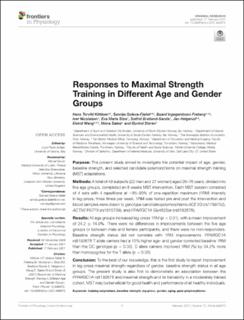| dc.contributor.author | Hans Torvild, Kittilsen | |
| dc.contributor.author | Goleva-Fjellet, Sannija | |
| dc.contributor.author | Freberg, Baard Ingegerdsson | |
| dc.contributor.author | Nicolaisen, Iver | |
| dc.contributor.author | Støa, Eva Maria | |
| dc.contributor.author | Bratland-Sanda, Solfrid | |
| dc.contributor.author | Helgerud, Jan | |
| dc.contributor.author | Wang, Eivind | |
| dc.contributor.author | Sæbø, Mona | |
| dc.contributor.author | Støren, Øyvind | |
| dc.date.accessioned | 2021-03-25T14:51:55Z | |
| dc.date.available | 2021-03-25T14:51:55Z | |
| dc.date.created | 2021-02-17T12:10:53Z | |
| dc.date.issued | 2021 | |
| dc.identifier.citation | Kittilsen, H. T., Goleva-Fjellet, S., Freberg, B. I., Nicolaisen, I., Støa, E. M., Bratland-Sanda, S., Helgerud, J., Wang, E., Sæbø, M. & Støren, Ø. (2021). Responses to Maximal Strength Training in Different Age and Gender Groups [Original Research]. Frontiers in Physiology, 12, 636972.. | en_US |
| dc.identifier.issn | 1664-042X | |
| dc.identifier.uri | https://hdl.handle.net/11250/2735582 | |
| dc.description.abstract | Purpose: The present study aimed to investigate the potential impact of age, gender, baseline strength, and selected candidate polymorphisms on maximal strength training (MST) adaptations.
Methods: A total of 49 subjects (22 men and 27 women) aged 20–76 years, divided into five age groups, completed an 8 weeks MST intervention. Each MST session consisted of 4 sets with 4 repetitions at ∼85–90% of one-repetition maximum (1RM) intensity in leg-press, three times per week. 1RM was tested pre and post the intervention and blood samples were drawn to genotype candidate polymorphisms ACE I/D (rs1799752), ACTN3 R577X (rs1815739), and PPARGC1A Gly482Ser (rs8192678).
Results: All age groups increased leg-press 1RM (p < 0.01), with a mean improvement of 24.2 ± 14.0%. There were no differences in improvements between the five age groups or between male and female participants, and there were no non-responders. Baseline strength status did not correlate with 1RM improvements. PPARGC1A rs8192678 T allele carriers had a 15% higher age- and gender corrected baseline 1RM than the CC genotype (p < 0.05). C allele carriers improved 1RM (%) by 34.2% more than homozygotes for the T allele (p < 0.05).
Conclusion: To the best of our knowledge, this is the first study to report improvement in leg-press maximal strength regardless of gender, baseline strength status in all age groups. The present study is also first to demonstrate an association between the PPARGC1A rs8192678 and maximal strength and its trainability in a moderately trained cohort. MST may be beneficial for good health and performance of all healthy individuals. | en_US |
| dc.language.iso | eng | en_US |
| dc.rights | Navngivelse 4.0 Internasjonal | * |
| dc.rights.uri | http://creativecommons.org/licenses/by/4.0/deed.no | * |
| dc.title | Responses to Maximal Strength Training in Different Age and Gender Groups | en_US |
| dc.type | Peer reviewed | en_US |
| dc.type | Journal article | en_US |
| dc.description.version | publishedVersion | en_US |
| dc.rights.holder | Copyright © 2021 Kittilsen, Goleva-Fjellet, Freberg, Nicolaisen, Støa, Bratland-Sanda, Helgerud, Wang, Sæbø and Støren. | en_US |
| dc.source.volume | 12 | en_US |
| dc.source.journal | Frontiers in Physiology | en_US |
| dc.identifier.doi | https://doi.org/10.3389/fphys.2021.636972 | |
| dc.identifier.cristin | 1890819 | |
| dc.source.articlenumber | 636972 | en_US |
| cristin.ispublished | true | |
| cristin.fulltext | original | |
| cristin.qualitycode | 1 | |

